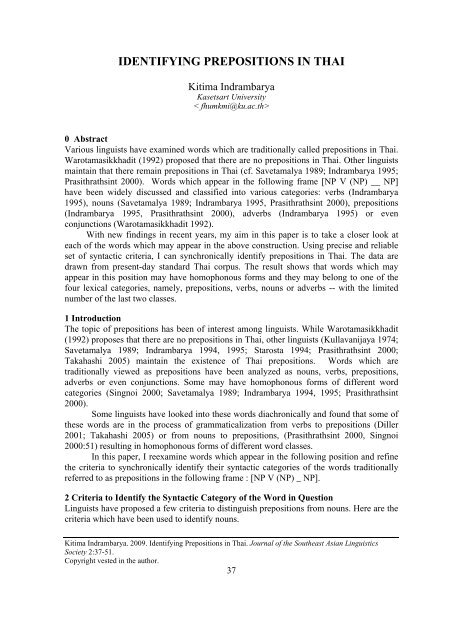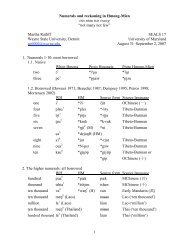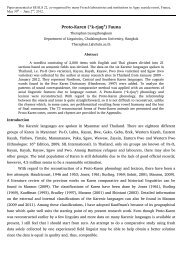proto-southwestern-tai revised: a new reconstruction - seals 22
proto-southwestern-tai revised: a new reconstruction - seals 22
proto-southwestern-tai revised: a new reconstruction - seals 22
You also want an ePaper? Increase the reach of your titles
YUMPU automatically turns print PDFs into web optimized ePapers that Google loves.
IDENTIFYING PREPOSITIONS IN THAI<br />
Kitima Indrambarya<br />
Kasetsart University<br />
< fhumkmi@ku.ac.th><br />
0 Abstract<br />
Various linguists have examined words which are traditionally called prepositions in Thai.<br />
Warotamasikkhadit (1992) proposed that there are no prepositions in Thai. Other linguists<br />
main<strong>tai</strong>n that there remain prepositions in Thai (cf. Savetamalya 1989; Indrambarya 1995;<br />
Prasithrathsint 2000). Words which appear in the following frame [NP V (NP) __ NP]<br />
have been widely discussed and classified into various categories: verbs (Indrambarya<br />
1995), nouns (Savetamalya 1989; Indrambarya 1995, Prasithrathsint 2000), prepositions<br />
(Indrambarya 1995, Prasithrathsint 2000), adverbs (Indrambarya 1995) or even<br />
conjunctions (Warotamasikkhadit 1992).<br />
With <strong>new</strong> findings in recent years, my aim in this paper is to take a closer look at<br />
each of the words which may appear in the above construction. Using precise and reliable<br />
set of syntactic criteria, I can synchronically identify prepositions in Thai. The data are<br />
drawn from present-day standard Thai corpus. The result shows that words which may<br />
appear in this position may have homophonous forms and they may belong to one of the<br />
four lexical categories, namely, prepositions, verbs, nouns or adverbs -- with the limited<br />
number of the last two classes.<br />
1 Introduction<br />
The topic of prepositions has been of interest among linguists. While Warotamasikkhadit<br />
(1992) proposes that there are no prepositions in Thai, other linguists (Kullavanijaya 1974;<br />
Savetamalya 1989; Indrambarya 1994, 1995; Starosta 1994; Prasithrathsint 2000;<br />
Takahashi 2005) main<strong>tai</strong>n the existence of Thai prepositions. Words which are<br />
traditionally viewed as prepositions have been analyzed as nouns, verbs, prepositions,<br />
adverbs or even conjunctions. Some may have homophonous forms of different word<br />
categories (Singnoi 2000; Savetamalya 1989; Indrambarya 1994, 1995; Prasithrathsint<br />
2000).<br />
Some linguists have looked into these words diachronically and found that some of<br />
these words are in the process of grammaticalization from verbs to prepositions (Diller<br />
2001; Takahashi 2005) or from nouns to prepositions, (Prasithrathsint 2000, Singnoi<br />
2000:51) resulting in homophonous forms of different word classes.<br />
In this paper, I reexamine words which appear in the following position and refine<br />
the criteria to synchronically identify their syntactic categories of the words traditionally<br />
referred to as prepositions in the following frame : [NP V (NP) _ NP].<br />
2 Criteria to Identify the Syntactic Category of the Word in Question<br />
Linguists have proposed a few criteria to distinguish prepositions from nouns. Here are the<br />
criteria which have been used to identify nouns.<br />
Kitima Indrambarya. 2009. Identifying Prepositions in Thai. Journal of the Southeast Asian Linguistics<br />
Society 2:37-51.<br />
Copyright vested in the author.<br />
37





